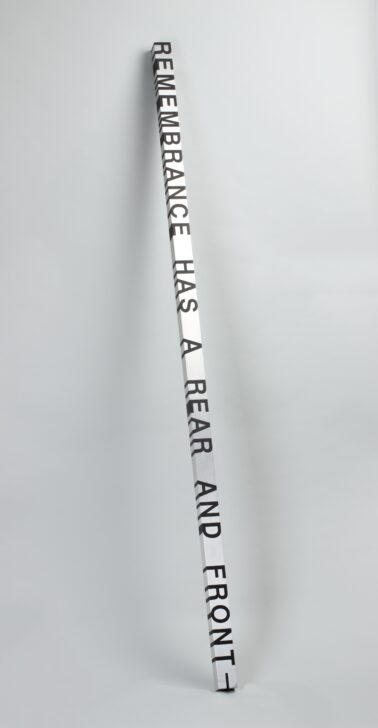Key and Cue No. 1182 (Remembrance has a rear and front)
Roni Horn

Description
Working across a range of media, Roni Horn often explores the relationship between words and materials. Horn’s Key and Cue sculptures transform language into a physical form that is both text and physical presence. This duality is reflected not only in the text itself—“Remembrance has a Rear and Front”—but also in the way that the work invites viewing from multiple perspectives. Seen from one angle, the text forms an abstract pattern, while from another it emerges as a poetic phrase: the first line of Emily Dickinson’s poem number 1182.
Remembrance has a Rear and Front –
‘Tis something like a House –
It has a Garret also
For Refuse and the Mouse.
Besides the deepest Cellar
That ever Mason laid --
Look to it by its Fathoms
Ourselves be not pursued --
Jacob Proctor, Associate Curator of Modern & Contemporary Art
------------------------------
6/28/10
Roni Horn (United States, born 1955)
Key and Cue No. 1182
1994
Aluminum and plastic
Gift of an anonymous donor
Working across a range of media, Roni Horn often explores the relationship between words and materials. Horn’s Key and Cue sculptures transform language into a physical form that is both text and physical presence. This duality is reflected not only in the text itself—“Remembrance has a Rear and Front”—but also in the way that the work invites viewing from multiple perspectives. Seen from one angle, the text forms an abstract pattern, while from another it emerges as a poetic phrase: the first line of Emily Dickinson’s poem number 1182.
Remembrance has a Rear and Front—
’Tis something like a House —
It has a Garret also
For Refuse and the Mouse.
Besides the deepest Cellar
That ever Mason laid—
Look to it by its Fathoms
Ourselves be not pursued—
Subject Matter:
One of a series of sculptures in which Horn transforms language into a physical form. Seen from one angle, the text forms an abstract pattern, while from another it emerges as a poetic phrase: the first line of Emily Dickinson’s poem number 1182.
Physical Description:
Aluminum shaft with block letters cast in black plastic.
Usage Rights:
If you are interested in using an image for a publication, please visit https://umma.umich.edu/request-image/ for more information and to fill out the online Image Rights and Reproductions Request Form.